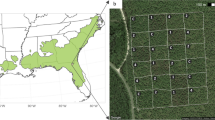Abstract
Compositional stability in forests has traditionally been evaluated by comparing understory with overstory composition. Such comparisons have generally been qualitative. Transition probability analysis has recently allowed quantitative prediction of future community states. We used transition probability analysis of an undisturbed spruce-fir forest to evaluate the sensitivity of the overstory/understory comparison to underlying assumptions. The predictions of future composition differed widely depending on understory size class used, ecological situation (gap versus forest plots), and stand descriptor (density versus frequency). Species longevities and interactions between understory and overstory species also affected the predictions. Understory data generally led to a predicted increase in importance for the most tolerant species (Abies fraseri) and the conclusion that a previous disturbance allowed the least tolerant species (Betula lutea) to become established. Inventory of stems in gaps led to a predicted increase in importance for the least tolerant species (Betula) and the conclusion that disturbance frequency was increasing in the stand. Data incorporating more detailed observations of the gap capture process led to the inference that this old growth stand was in compositional equilibrium. In this community, the species that was densest in the understory species (Abies) had the shortest lifespan and thus, the fastest canopy turnover rate. This lead to counter-intuitive behavior in the models; in some cases Abies had a 40% higher relative density in the understory than in the overstory at equilibrium.
Similar content being viewed by others
References
Barden L. S., 1980. Tree replacement in cove hardwood forest of the southern Appalachians. Oikos 35: 16–19.
Barden L. S., 1981. Forest development in canopy gaps of a diverse hardwood forest of the southern Appalachians. Oikos 37: 205–209.
Buell M. F., Langford A. N., Davidson D. W., & Ohmann L. F., 1966. The upland forest continuum in northern New Jersey. Ecology 47: 416–432.
Daubenmire R. B., 1936. The ‘big woods’ of Minnesota. Ecol. Monogr. 6: 233–268.
Dix R. L., 1957. Sugar maple in the climax forests of Washington, D. C., Ecology 38: 663–665.
Fox J. F., 1977. Alternation and coexistence of tree species. Am. Nat. 111: 69–89.
Grime J. P., 1979. Plant strategies and vegetation processes. John Wiley & Sons, London. 222 pp.
Hobbs R. J., 1983. Markov models in the study of post-fire succession in heathland communities. Vegetatio 56: 17–30.
Hobbs R. J. & Legg C. J., 1983. Markov models and initial floristic composition in heathland dominated vegetation dynamics. Vegetatio 56: 31–43.
Horn H. S., 1975. Markovian processes in forest succession. In: M. L. Cody & J. M. Diamond (eds.). Ecology and evolution of communities. pp. 196–211 Harvard Univ. Press. Cambridge, Mass.
Langford A. N. & Buell M. F., 1969. Integration, identity, and stability in the plant association. Adv. Ecol. Res. 6: 83–135.
Oosting H. J. & Billings D. W., 1951. A comparison of virgin spruce-fir forest in the northern and southern Appalachian system. Ecology 32: 84–103.
Peet R. K., & Christensen N. L., 1980. Succession: a population process. Vegetatio 43: 131–140.
Pickett S. T. A., 1980. Non-equilibrium coexistence of plants. Bull. Torrey Botanical Club 107: 238–248.
Runkle J. R., 1981. Gap regeneration in some old-growth forests of the eastern United States. Ecology 62: 1041–1051.
Runkle J. R., 1984a. Development of woody vegetation in treefall gaps in a beech-sugar maple forest. Holartic Ecology 7: 157–164.
Runkle J. R., 1985. Disturbance regimes in temperate forests. In: S. T. A. Pickett & P. S. White (eds.). Natural disturbance, the patch dynamics perspective. pp. 17–33 Academic Press. New York.
Shugart H. H., 1984. A theory of forest dynamics: the ecological implications of forest succession models. Springer-Verlag. New York. 278 pp.
Usher M. B., 1979a. Markovian approaches to ecological succession. J. Animal Ecology 48: 413–426.
Usher M. B., 1979b. Modelling ecological succession, with particular reference to Markovian models. Vegetatio 46: 11–18.
van Hulst R., 1980. Vegetation dynamics or ecosystem dynamics: dynamic sufficiency in successional theory. Vegetatio 43: 147–151.
White P. S., 1979. Pattern, process, and natural disturbance in vegetation. Botanical Review 45: 229–299.
Woods K. D., 1984. Patterns of tree replacement: canopy effects on understory pattern in hemlock-northern hardwood forest. Vegetatio 56: 87–107.
Woods K. & Whittaker R. H., 1981. Canopy-understory interaction and the internal dynamics of mature hardwood and hemlock-hardwood forests. In: D. C. West, H. H. Shugart & B. D. Botkin (eds.). Forest succession. pp. 305–323 Springer-Verlag. New York. 517 pp.
Author information
Authors and Affiliations
Rights and permissions
About this article
Cite this article
White, P.S., MacKenzie, M.D. & Busing, R.T. A critique on overstory/understory comparisons based on transition probability analysis of an old growth spruce-fir stand in the Appalachians. Vegetatio 64, 37–45 (1985). https://doi.org/10.1007/BF00033452
Accepted:
Issue Date:
DOI: https://doi.org/10.1007/BF00033452




